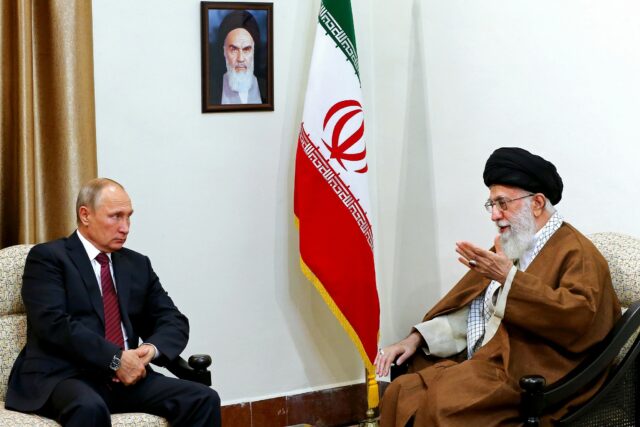
The Emerging Russo-Iranian Entente
Publication: Eurasia Daily Monitor Volume: 19 Issue: 189
By:

The fact that Iran has been transferring drones to Russia and is even helping manufacture them within Russia is well known by now (Ibtimes.com, November 21). But this bilateral cooperation has not stopped at drones but has expanded to encompass regular arms deliveries by Tehran to Moscow, the transfer of Russian weapons to Iran and a growing agenda of deepened security cooperation. In other words, a genuine entente is taking shape before our eyes. Indeed, Russia has requested a second large transfer of Iranian drones as well as surface-to-surface missiles in the past month (Radio Free Europe/Radio Liberty, November 15). In return, Moscow has apparently provided Tehran with stolen weapons from the West as well as cash (The Jerusalem Post, November 8). Thus, Iran will be able to study these weapons and learn how to make them through reverse-engineering the delivered systems.
Meanwhile, it is possible that the modifications Russian forces introduced to the Shaheed-136 drone to improve its accuracy may have been communicated to Iran ahead of time, as suggested by the drone strike on an Israeli-owned oil tanker on November 15 (Asiatimes.com, November 17). In that case, these Russian re-engineered Iranian drones could pose a major existential threat to shipping routes not only in the Persian Gulf but also in the Black, Baltic and Mediterranean seas, as well as the Indian Ocean. Given Iran’s extensive naval ambitions in the Mediterranean, the Gulf and the Indian Ocean, these weapons could serve as part of a sea-denial strategy that would be the first step in realizing at least some of Tehran’s ambitions (Epc.ae, November 28).
In other examples of defense cooperation, Asia Times Online reported in August 2022 that Iran had launched its Khayyam satellite using a Russian Soyuz rocket from the Baikonur Cosmodrome (Asiatimes.com, August 10). Iranian sources report that this satellite can be used for “border surveillance of agriculture, monitoring land use changes such as unauthorized construction, deforestation and environmental hazards and scouting for mineral deposits, among others.” The satellite could also be used to conduct reconnaissance of Ukrainian groupings and weapons systems (Russianspaceweb.com, August 11). Since 2018, Russia and Iran have also been negotiating for the delivery of a Russian Kanopus-V satellite with “high-resolution cameras” to Tehran, which would significantly increase Iran’s space-based espionage capabilities in the Middle East (Radio Free Europe/Radio Liberty, June 11, 2021). US intelligence officials also believe that Iran is seeking Russia’s help in bolstering its nuclear program, specifically with nuclear materials and fuel fabrication (The Jerusalem Post, November 1). If Tehran is receiving such help, the Iranian nuclear program could advance more quickly to “nuclear latency” in which Iran does not actually possess a usable nuclear weapon but could assemble one in a relatively short amount of time (Apa.az, November 4).
Additionally, Russo-Iranian political and economic relations are strengthening. This reflects the shared anti-American sentiments that largely drive Moscow’s and Tehran’s policies. In recent talks, Iran and Russia defined new frameworks and mechanisms for deepening their relationship that go beyond Syria and military transfers to include the Caucasus, where Iran is already expanding its influence to the point of dangerously mounting tensions with Azerbaijan and Turkey (Tasnim News Agency, December 4).
These mechanisms also include upgraded bilateral economic ties. This particular form of enhancement of ties actually preceded Russia’s war against Ukraine and now will clearly deepen as the two pariah states draw more closely together (Islamic Republic News Agency, February 1). Thus, it appears that a gas swap, which would allow Iran to import Russian gas and then export it to third countries, is in the works (Cnsnews.com, August 25). More recently, in talks between Putin and Iranian President Ebrahim Raisi, the two leaders “touched upon some pressing bilateral issues with a focus on how to build up cooperation in the political, trade and economic areas, including in the field of transport and logistics” (Al Jazeera, November 12). Iran has also proposed a joint working group to circumvent Western sanctions (Iranintl.com, March 30). Lastly, Iran has reportedly asked Russia for help in suppressing the long-running demonstrations across the country by transferring Russian anti-riot equipment and training to Tehran (Iranintl.com, December 12).
Thus, it is clear that the Russo-Iranian entente is multi-dimensional and growing, encompassing economic-political-military transactions that aim to affect politics in the Middle East and the Caucasus, as well as the war in Ukraine. It is also clear that this relationship is already having reverberations among other interested parties. In Israel, for example, the outgoing government of Yuri Lapid has called bilateral Russo-Iranian ties “dangerous,” and some believe that the incoming Netanyahu government may see things differently (The Jerusalem Post, October 24). Apart from the abiding anxiety regarding Iran’s nuclear program, Israel fears that this new entente will give Tehran cover in Syria to expand its activities up to the Israeli border, as Russia might step in to limit Israeli air strikes against Iranian facilities and installations there (The Jerusalem Post, November 16). Meanwhile, taking advantage of the increasingly visible estrangement between Riyadh and Washington, Moscow is trying to facilitate a means by which Iran and Saudi Arabia might mend their differences, a development that, if it occurs, would send shockwaves throughout the Middle East (Middleeastmonitor.com, November 8).
Consequently, this entente is fraught with danger for Ukraine; the Caucasus; Azerbaijan, in particular; and the Middle East. It ties much of the agenda of security in the Middle East to the war in Ukraine and could facilitate a major rupture in the non-proliferation order. For these reasons, this remains a relationship that cannot be overlooked.



